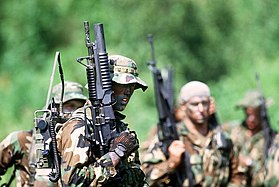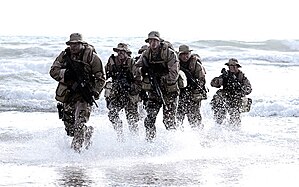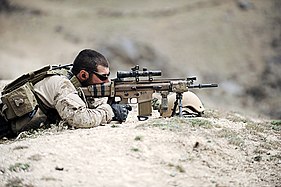United States Navy SEALs
- العربية
- Asturianu
- Azərbaycanca
- বাংলা
- Български
- Brezhoneg
- Català
- Čeština
- Dansk
- Deutsch
- Eesti
- Español
- Esperanto
- Euskara
- فارسی
- Français
- 한국어
- Hrvatski
- Bahasa Indonesia
- Italiano
- עברית
- ქართული
- Latina
- मराठी
- Bahasa Melayu
- Nederlands
- 日本語
- Norsk bokmål
- Polski
- Português
- Română
- Русский
- Shqip
- Simple English
- Slovenščina
- Suomi
- Svenska
- தமிழ்
- ไทย
- Türkçe
- Українська
- 中文
| United States Navy SEALs | |
|---|---|
Counter narcotic operations | |
| Part of | |
| Garrison/HQ | Naval Amphibious Base Coronado Joint Expeditionary Base–Little Creek |
| Nickname(s) | "Frogmen", "The Teams", "Team Guys", "The Men with Green Faces"[1] |
| Motto(s) | "The Only Easy Day Was Yesterday"[2] "It Pays To Be A Winner". "Never Out Of The Fight". |
| Engagements |
|
The United States Navy Sea, Air, and Land (SEAL) Teams, commonly known as Navy SEALs, are the
Depending on the availability of platforms, threat level, and environment, different methods can be used for the insertion and extraction of SEALs into a target location. This could include nuclear-powered cruise missile submarines equipped with dry deck shelters, SDV submarines, surface vessels, surface swimming, or other vehicles.
All active SEALs are members of the U.S. Navy.
History
Origins
Although not formally founded until 1962, the modern-day U.S. Navy SEALs trace their roots to
Scouts and Raiders
Recognizing the need for a beach reconnaissance force, a select group of Army and Navy personnel assembled at Amphibious Training Base (ATB) Little Creek, Virginia on 15 August 1942 to begin Amphibious Scouts and Raiders (Joint) training. The Scouts and Raiders' mission was to identify and reconnoiter the objective beach, maintain a position on the designated beach prior to a landing, and guide the assault waves to the landing beach.[7] The unit was led by U.S. Army 1st Lieutenant Lloyd Peddicord as commanding officer, and Navy Ensign John Bell as executive officer. Navy Chief Petty Officers and sailors came from the boat pool at U. S. Naval Amphibious Training Base, Solomons, Maryland, and Army Raider personnel came from the 3rd and 9th Infantry Divisions. They trained at Little Creek until embarking for the North Africa campaign the following November. Operation Torch was launched in November 1942 off the Atlantic coast of French Morocco in North Africa.[17]
The first group included Phil H. Bucklew, the "Father of Naval Special Warfare," after whom the Naval Special Warfare Center building is named. Commissioned in October 1942, this group saw combat in November 1942 during Operation Torch on the North African Coast. Scouts and Raiders also supported landings in Sicily, Salerno, Anzio, Normandy, and southern France.[18]
The second group of Scouts and Raiders, code-named Special Service Unit No. 1, was established on 7 July 1943, as a joint and combined operations force. The first mission, in September 1943, was at Finschhafen in Papua New Guinea. Later operations were at Gasmata, Arawe, Cape Gloucester, and the east and south coasts of New Britain, all without any loss of personnel. Conflicts arose over operational matters, and all non-Navy personnel were reassigned. The unit, renamed 7th Amphibious Scouts, received a new mission, to go ashore with the assault boats, buoy channels, erect markers for the incoming craft, handle casualties, take offshore soundings, clear beach obstacles, and maintain voice communications linking the troops ashore, incoming boats and nearby ships. The 7th Amphibious Scouts conducted operations in the Pacific for the duration of the conflict, participating in more than 40 landings.[7]
The third and final Scouts and Raiders organization operated in China. Scouts and Raiders were deployed to fight with the
Naval Combat Demolition Units (NCDUs)
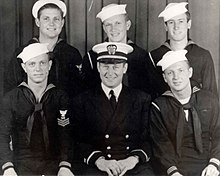
In September 1942, 17 Navy salvage personnel arrived at ATB
In early May 1943, a two-phase "Naval Demolition Project" was directed by the
By April 1944, a total of 34 NCDUs were deployed to England in preparation for
Thirty NCDUs
OSS Maritime Unit
Much like their brethren in the
The OSS executed special operations, dropping operatives behind enemy lines to engage in organized guerrilla warfare as well as to gather information on such things as enemy resources and troop movements.
The OSS MU mission was "to infiltrate agents and supply resistance groups by sea, conduct maritime sabotage, and develop specialized maritime surface and subsurface equipment and devices." The MU operated in several theaters. In the Mediterranean, a fleet of hired Greek wooden fishing vessels—called caiques—covertly supported OSS agents in Albania, Greece, and Yugoslavia. After Italy surrendered, the MU and Mariassalto, an elite Italian special operations naval unit, operated against the Germans. In the Far East, the MU operated in conjunction with an Operational Group to attack Japanese forces on the Arakan coast of Burma. They jointly conducted reconnaissance missions on the Japanese-held coast, sometimes penetrating several miles up enemy-controlled rivers.[30]
The MU developed or used several innovative devices that would later allow for the creation of a special operations combat-diver capability, first in Army Special Forces (Green Berets) and later in US Navy SEAL units. Perhaps the most important invention in the realm of special operations diving was the
Lambertsen began his involvement with OSS as a medical student offering the use of his technology to the secretive organization in 1942. In 1944 he was commissioned as an Army Officer and later joined the OSS as an Operational Swimmer. Lambertsen himself led the OSS Maritime Unit on covert underwater missions to attach explosives to Japanese ships.[31] Dr. Christian Lambertsen is remembered today as the 'Father of Military Underwater Operations'. Along with all the members of the OSS Maritime Unit, he was made honorary Green Berets and recognized by organizations like the UDT Navy Seal Association for their heroic and critical work.[dead link][32]
In May 1944, Colonel "Wild Bill"
Underwater Demolition Teams (UDTs)
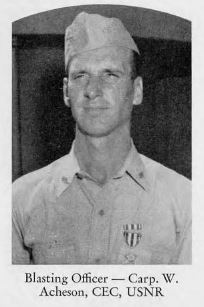
When Teams 1 and 2 were initially formed, they were "provisional" with 180 men in total.
After the operations in the Marshall Islands, Admiral Turner restructured the two provisional UDT units and created 7 permanent units with an allotted size of 96 men per team. In the name of operational efficiency, the UDTs were also made an-all Navy outfit, and any Army and Marine corp engineers were returned to their units. Moving forward, the UDTs would employ the reconnaissance method made successful in Kwajalein - daytime use of swimsuits and goggles instead of the Scouts and Raiders method of nighttime rubber boats. In order to implement these changes and grow the UDTs, Koehler was made the commanding officer of the Naval Combat Demolition Training and Experimental Base on Maui. Admiral Turner also brought on LCDR Draper Kauffman as a combat officer.[37]
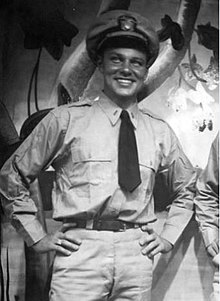
Seabees made up the vast majority of the men in teams 1–9, 13, and 15.[41][42] Seabees were roughly 20% of UDT 11.[41] The officers were mostly CEC.[43] At war's end 34 teams had been formed with teams 1–21 having actually been deployed. The Seabees provided over half of the men in the teams that saw service.
The UDT uniform had transitioned from the combat fatigues of the NCDUs to trunks,
These "Naked Warriors", as they came to be called post-war, saw action in every major Pacific
The last UDT operation of the war was on 4 July 1945 at Balikpapan, Borneo. The rapid demobilization at the conclusion of the war reduced the number of active duty UDTs to two on each coast with a complement of seven officers and 45 enlisted men each.[11] However, the UDTs were the only special troops that avoided complete disbandment after the war, unlike the OSS Maritime Unit, the VAC Recon Battalion, and several Marine recon missions.[37]
Because they were so integral to the success of missions in the Pacific during the war, the U.S. Navy did not publicize the existence of the UDTs until post-war.
For the Marianas operations of Kwajalein,
Korean War
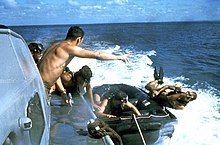
The
Through their focused efforts on demolitions and mine disposal, the UDTs refined and developed their commando tactics during the Korean War. The UDTs also accompanied South Korean commandos on raids in the North to demolish train tunnels. This was frowned upon by higher-ranking officials because they believed it was a non-traditional use of Naval forces. Due to the nature of the war, the UDTs maintained a low operational profile. Some of the missions included transporting spies into North Korea and the destruction of North Korean fishing nets used to supply the North Korean Army.[7]
As part of the Special Operations Group, or SOG, UDTs successfully conducted demolition raids on railroad tunnels and bridges along the Korean coast. The UDTs specialized in a somewhat new mission: Night coastal demolition raids against railroad tunnels and bridges. The UDT men were given the task because, in the words of UDT LT Ted Fielding, "We were ready to do what nobody else could do, and what nobody else wanted to do." (Ted Fielding was awarded the Silver Star during Korea, and was later promoted to the rank of Captain.)[50]
On 15 September 1950, UDTs supported Operation Chromite, the amphibious landing at Incheon. UDT 1 and 3 provided personnel who went in ahead of the landing craft, scouting mud flats, marking low points in the channel, clearing fouled propellers, and searching for mines. Four UDT personnel acted as wave-guides for the Marine landing. In October 1950, UDTs supported mine-clearing operations in Wonsan Harbor where frogmen would locate and mark mines for minesweepers. On 12 October 1950, two U.S.minesweepers hit mines and sank. UDTs rescued 25 sailors. The next day, William Giannotti conducted the first U.S. combat operation using an "aqualung" when he dived on USS Pledge. For the remainder of the war, UDTs conducted beach and river reconnaissance, infiltrated guerrillas behind the lines from sea, continued mine sweeping operations and participated in Operation Fishnet, which devastated the North Koreans' fishing capability.[7]
Birth of Navy SEALs and the Vietnam War
President
The Navy needed to determine its role within the special operations arena. In March 1961,
The first two teams were formed in January 1962
According to founding SEAL team member Roy Boehm, the SEALs' first missions were directed against communist Cuba. These consisted of deploying from submarines and carrying out beach reconnaissance in a prelude to a proposed US amphibious invasion of the island. On at least one occasion, Boehm and another SEAL had smuggled a CIA agent ashore to take pictures of Soviet nuclear missiles being unloaded on the dockside.[53]
The
The
The SEALs were initially deployed in and around Da Nang, training the South Vietnamese in combat diving, demolitions and guerrilla/anti-guerrilla tactics. As the war continued, the SEALs found themselves positioned in the Rung Sat Special Zone where they were to disrupt the enemy supply and troop movements and in the Mekong Delta to fulfill riverine operations, fighting on the inland waterways.

Combat with the VC was direct. Unlike the conventional warfare methods of firing artillery into a coordinate location, the SEALs operated close to their targets. Into the late 1960s, the SEALs were successful in a new style of warfare, effective in anti-guerrilla and guerrilla actions. SEALs brought a personal war to the enemy in a previously safe area. The VC referred to them as "the men with green faces," due to the camouflage face paint the SEALs wore during combat missions.[54]
In February 1966, a small SEAL Team One detachment arrived in South Vietnam to conduct direct action missions. Operating from Nhà Bè Base, near the Rung Sat Special Zone, this detachment signalled the beginning of a SEAL presence that would eventually include 8 SEAL platoons in country on a continuing basis. SEALs also served as advisors for Provincial Reconnaissance Units and the Lein Doc Nguio Nhia, the Vietnamese SEALs.[11]
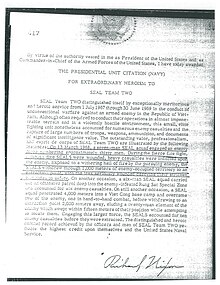
SEALs continued to make forays into North Vietnam and Laos and covertly into

By 1970, President
Reorganization
On 1 May 1983, UDT–11 was redesignated as SEAL Team Five, UDT–21 was redesignated as SEAL Team Four, UDT–12 became
Grenada
Both SEAL Team Four and SEAL Team Six, the predecessor to
The team sent to the radio station also ran into communication problems. As soon as the SEALs reached the radio facility they found themselves unable to raise their command post. After beating back several waves of Grenadian and Cuban troops supported by BTR-60 armored personnel carriers, the SEALs decided that their position at the radio tower was untenable. They destroyed the station and fought their way to the water where they hid from patrolling enemy forces. After the enemy had given up their search, the SEALs, some wounded, swam into the open sea where they were extracted several hours later after being spotted by a reconnaissance aircraft.
Iran–Iraq War
During the closing stages of the Iran–Iraq War the United States Navy began conducting operations in the Persian Gulf to protect US-flagged ships from attack by Iranian naval forces. A secret plan was put in place and dubbed Operation Prime Chance. Navy SEAL Teams 1 and 2 along with several Special Boat Units and EOD technicians were deployed on mobile command barges and transported by helicopters from the Army's 160th Special Operations Aviation Regiment. Over the course of the operation SEALs conducted VBSS (visit, board, search, and seizure) missions to counter Iranian mine-laying boats. The only loss of life occurred during the takedown of the Iran Ajr. Evidence gathered on the Iran Ajr by the SEALs later allowed the US Navy to trace the mines that struck USS Samuel B. Roberts (FFG-58). This chain of events led to Operation Praying Mantis, the largest US Naval surface engagement since the Second World War.
During Operation Desert Shield and Storm, Navy SEALs trained Kuwaiti Special Forces. They set up naval special operations groups in Kuwait, working with the Kuwaiti Navy in exile. Using these new diving, swimming, and combat skills, these commandos took part in combat operations such as the liberation of the capital city.
Panama

The United States Navy contributed extensive special operations assets to Panama's invasion, codenamed
The strike on Balboa Harbor by Task Unit Whiskey is notably marked in SEAL history as the first publicly acknowledged combat swimmer mission since the Second World War. Prior to the commencement of the invasion four Navy SEALs swam underwater into the harbor on
Task Unit Papa was tasked with the seizure of Paitilla airfield and the destruction of Noriega's plane there. Several SEALs were concerned about the nature of the mission assigned to them being that airfield seizure was usually the domain of the
Persian Gulf War
In August 1990, SEALs were the first western forces to deploy to the
Somalia Intervention
On 6 December 1992, as part of Operation Restore Hope, U.S. Navy SEALs and Special Boat crewmen from Naval Special Warfare Task Unit TRIPOLI began a three-day operation carrying out reconnaissance operations in the vicinity of Mogadishu airport and harbor; ahead of UNITAFs deployment to the country. They suffered only one casualty, who was injured by an IED.[61][62]
In August 1993 a four-person DEVGRU SEAL sniper team was deployed to Mogadishu to work alongside
War in Afghanistan
Invasion
In the immediate aftermath of the
As part of the CJSOTF (Combined Joint Special Operations Task Force) under the command of General
The task force's principal task was to conduct SR and
SEALs were present at the
Before the US Marines landed at
Post-invasion
In January 2002, following the
In February 2002, while at Camp Rhino, the
In March 2002, SEALs from DEVGRU, SEAL Teams 2, 3 and 8 participated extensively in

Later in 2002, CJSOFT became a single integrated command under the broader CJTF-180 that commanded all US forces assigned to OEF-A, it was built around an Army Special Forces Group (composed of soldiers from National Guard units) and SEAL teams. A small JSOC element (formerly Task Force Sword/11) not under direct CTJF command—embedded within CJSOFT, it consisted of a joint SEAL and Ranger element that rotated command, and was not under direct ISAF command, although it operated in support of NATO operations.[69]
In June 2005, Lieutenant Michael P. Murphy was posthumously awarded the Medal of Honor after his four-man reconnaissance counterinsurgency team was almost wiped out during Operation Red Wings. After the four-man team lost Danny Dietz, he put himself in open view to call in the QRF. He soon after died from injuries sustained. Matthew Axelson also died on this operation. The QRF never reached the scene; it was struck by an RPG killing eight Navy SEALs and eight Army Night Stalkers. Marcus Luttrell was the only survivor from this operation.
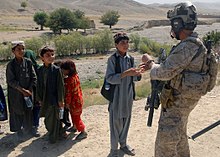
In early 2010, Brigadier General
On 6 August 2011, seventeen U.S. Navy SEALs were killed when their
On 16 August 2012, SEALs in Uruzgan Province conducted a joint operation into the Shah Wali Kot Valley where they suffered the loss of a Black Hawk helicopter when it was struck by an insurgent RPG, the crash killed 11 servicemen (seven US and four Afghan).[76]
In December 2012, SEALs from DEVGRU rescued a US doctor who had been kidnapped a few days earlier. However, during the operation the unit suffered a fatality, Petty Officer 1st Class Nicolas D. Checque.[77] Senior Chief Edward Byers, was awarded the Medal of Honor for his actions during this mission.[78]
In May 2013, Rear Admiral
Iraq War
Invasion
For the
Several days before the beginning of the invasion, two SDV teams were launched from
The shore-based pumping stations (known as MMS-Monitoring and Meter Stations) and their pipelines on the
Other Naval Task Group operations included elements of three SEAL platoons in GMV trucks and DPVs seizing the al Zubayr MMS, whilst
Coalition military planners were concerned that retreating Iraqi forces would destroy the Mukatayin hydroelectric dam, located 57 miles northeast of Baghdad, in an attempt to slow advancing US troops. In addition to restricting the manoeuvre of Coalition forces, the destruction of the dam would deny critical power needs to the surrounding area, as well as cause massive flooding and loss of Iraqi civilian life. A mixed team of SEALs from SEAL Team 5 and Polish GROM was called in to seize the dam. This force was flown several hours by six US Air Force
During the
Post-invasion Iraq

Following the invasion, SEAL platoons rotated through
In the interim between the First Battle of Fallujah and
From 2005, SEALs were heavily committed to western Iraq in
As the SEALs were beginning to make headway in Ramadi, AQI was starting to infiltrate the area by targeting local
In Fallujah, the SEAL Task Unit were also heavily involved in fighting. In one joint operation to capture an AQI leader, they entered the target building and were engaged resulting in an Iraqi Scout being killed and a SEAL severely wounded, two SEALs returned fire and entered the building, both SEALs entered different rooms, in one room the SEAL encountered three insurgents who opened fired at close range, another SEAL across the hallway was struck in the head and killed, the SEAL in the room with the insurgents killed all three.[97]
In September 2009, in a nighttime raid in Fallujah, SEALs captured
SEALS remained employed throughout the Iraqi Campaign as Task Units or Task Elements until its close in 2011.
Operation Enduring Freedom – Philippines
OEF-P was established in 2002 to conduct long-term partnered operations with both Philippine Army special operations and intelligence units, as well as police units, to counter the threat posed by the
Operation Enduring Freedom – Horn of Africa
As part of OEF-HOA, Naval Special Warfare Unit 10 are deployed to Camp Lemonnier, Djibouti, under the command of SOCCE-HOA (Special Operations Command and Control Element-Horn of Africa) which commands all SOCOM units assigned to training or operational missions in the region. Special operations carried out in Somalia are conducted under the codename: Operation Octave Dune, as part of the overall effort in Somalia, which is known as Operation Octave Shield.[103]
Before Djibouti became the epicentre for counter terrorism operations in Africa, unilateral operations were launched from temporary forward locations in friendly nations such as Kenya, or from US Navy ships. The earliest known operation in Somalia was known as Operation Cobalt Blue: In 2003, SEALs using SEAL Delivery Vehicles swam ashore along the Somali coastline and emplaced covert surveillance cameras. Known as cardinals, the cameras were designed to watch likely target locations for wanted terrorists as al-Qaeda and its affiliates began to regroup in the country, however the cameras only took one image a day and captured very little.[104]
CJSOTF-HOA (Combined Joint Special Operations Task Force-Horn of Africa) developed a rescue plan called Operation Mystic Talon, in case any CIA SAD or ISA operators were captured in the region, the plan required a SEAL platoon with Air Force Special Operations assets that, if necessary, would fight their way into Somalia, recover the hostage and fight their way out, should a mission need to be launched before a dedicated JSOC task force could be deployed to the region.[105]
Maersk Alabama hijacking
On 12 April 2009, in response to a hostage taking incident off the coast of
Death of Osama bin Laden
In the early morning of 2 May 2011
Morning Glory oil tanker
On 16 March 2014, thirty U.S. Navy SEALs from SEAL Team 2 took control of MV Morning Glory, a tanker full of oil loaded from a rebel-held port in Libya. The raid by Navy SEALs took place in international waters off the coast of Cyprus; the raid was a success, preventing a Libyan splinter militia group selling nationalized Libyan oil on the black market.[112][113]
Operation Inherent Resolve
As part of
Personnel
Selection and training

Before getting accepted into Basic Underwater Demolition/SEAL (BUD/S) training, a prospective candidate must pass a certain number of both mental and physical
The average candidate spends over a year in a series of formal training courses before being awarded the Special Warfare Operator Naval Rating and the Navy Enlisted Classification
Navy SEAL training pipeline:
- 8-week Naval Recruit Training
- 8-week Naval Special Warfare Prep School (Pre-BUD/S)
- 3-week BUD/S Orientation
- 24-week Basic Underwater Demolition/SEAL Training (BUD/S)[121]
- 3-week Army airborne School
- 26-week SEAL Qualification Training (SQT)
Upon graduation from SQT, trainees receive the U.S. Navy SEAL Trident, designating them as Navy SEALs. They are subsequently assigned to a SEAL Team or SEAL Delivery Vehicle (SDV) Team and begin 18 months of predeployment training before they are considered deployable. This training consists of:[122][123]
- 6-month Professional Development – Individual Specialty Training (ProDev)
- 6-month Unit Level Training (ULT). ULT is unit training conducted by each Groups Training Detachment. Core unit training blocks are Air Operations, Land Warfare, Maritime, Urban and Special Reconnaissance.
- 6-month Squadron Integration Training (SIT)[124]
Those enlisted SEALs with a medical rating will first attend the Special Operations Combat Medic Course for 6 months in Fort Bragg, North Carolina[125] before joining a team in order to become a SEAL/Special Operator Corpsman. Those pursuing Officer positions first attend the Junior Officer Training Course (JOTC) to learn about operations planning and how to perform team briefings. In total it can take over two-and-a-half years to completely train a Navy SEAL for his first deployment.[122][123]
Women
Until December 2015, female sailors were barred from becoming Navy SEALs by naval regulation; however, this prohibition no longer exists. As early as August 2015, it was reported that the "Navy is planning to open its elite SEAL teams to women who can pass the grueling training regimen."
Since the Navy opened up special warfare jobs to female sailors in 2016, 18 women have attempted to pass
The Washington Examiner reported on 10 August 2017: "A woman aiming to become the first female Navy SEAL officer quit about a week into the initial training".[129]
In 2019 the Navy announced that an unnamed female officer was the first to successfully complete the SEAL Officer Assessment and Selection program (SOAS). She was one of a group of five female candidates to enter the program. She opted not to start BUD/S afterwards, instead choosing another assignment in the Navy.[130][131]
In July 2021, the Naval Special Warfare (NSW) training program graduated its first woman operator, who would go on to become a Special Warfare Combatant-craft Crewman (SWCC). This would mark the first time a woman has graduated from the NSW assessment and selection pipeline.[132][133]
Issues
In December 2016, the SEALs halted all training and ordered a safety stand-down because of substance abuse within its ranks.[134] As part of the safety stand-down, all SEALs were required to submit to urinalysis.[134] In August 2019, a review of the culture of Special Operations Command was ordered following cases of misconduct involving the SEALS, which included substance abuse by members of SEAL Team 10 and allegations of sexual assault and intoxication by a SEAL platoon in Iraq.[135]
Navy SEAL teams and structures


The total number of personnel, including SEALs and
Naval Special Warfare Groups
Naval Special Warfare Command is organized into the following configuration:[137]
- Naval Special Warfare Group 1 – based at the Naval Amphibious Base Coronado in California
- SEAL Team 1
- SEAL Team 3
- SEAL Team 5
- SEAL Team 7
- Naval Special Warfare Group 2 – based at the Joint Expeditionary Base–Little Creek in Virginia
- SEAL Team 2
- SEAL Team 4
- SEAL Team 8
- SEAL Team 10
- Naval Special Warfare Group 4 – based at the Joint Expeditionary Base Little Creek in Virginia
- Special Boat Team 12
- Special Boat Team 20
- Special Boat Team 22
- Naval Special Warfare Group 8[138] – based at the Joint Expeditionary Base Little Creek in Virginia[139][140][141]
- SEAL Delivery Vehicle Team 1
- SEAL Delivery Vehicle Team 2
- Special Reconnaissance Team 1
- Special Reconnaissance Team 2
- Logistics Support 3
- Training Detachment 3
- Mission Support Center ("organize, train, educate, equip, deploy and sustain specialized intelligence, surveillance, reconnaissance and preparation-of-the-environment capabilities")[142]
- Naval Special Warfare Group 11 – based at the Naval Amphibious Base Coronado in California
- JSOC
- Red Squadron
- Blue Squadron
- Gold Squadron
- Silver Squadron
- Black Squadron
- Grey Squadron
Inactivated Groups:
- Naval Special Warfare Group 3 – previously based at the Naval Amphibious Base Coronado in California; deactivated in 2021[139][140]
- Naval Special Warfare Group 10 – previously based at the Naval Amphibious Base Little Creek in Virginia; deactivated in 2021[139][140]
SEAL Teams
The original SEAL Teams were separated between West Coast (Team One) and East Coast (Team Two) SEALs. Likewise current SEAL Teams are organized into two groups: Naval Special Warfare Group One (West Coast) and Naval Special Warfare Group Two (East Coast), both of which come under the command of
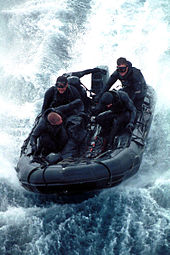
The Teams deploy as Naval Special Warfare Squadrons or Special Operations Task Forces and can deploy anywhere in the world. Squadrons will normally be deployed and fall under a Joint Task Force (JTF) or a Combined Joint Special Operations Task Force (CJSOTF) as a Special Operations Task Force (SOTF).
Each SEAL Team (or "squadron") is commanded by a Navy commander (O-5), and has eight operational SEAL platoons and a headquarters element. Operationally, the "Team" is divided into two to four 40-man "task units" (or "troops"). Each task unit consists of a headquarters element consisting of a task unit commander, typically a lieutenant commander (O-4), a task unit senior enlisted (E-8), a targeting/operations officer (O-2/3) and a targeting/operations leading/chief petty officer (E-6/7). Under the HQ element are two to four SEAL platoons of 16 men (two officers and 14 enlisted SEALs, and sometimes assigned non-NSW support personnel); a company-sized combat service support (CSS) and/or combat support (CS) consisting of staff N-codes (the Army and Marine Corps use S-codes); N1 Administrative support, N2 Intelligence, N3 Operations, N4 Logistics, N5 Plans and Targeting, N6 Communications, N7 Training, and N8 Air/Medical.
Each 16-man platoon can be task organized for operational purposes into two eight-man squads, four four-man fire teams, or eight two-man sniper/reconnaissance teams. The size of each SEAL "Team", or "squadron", with two to four task units (containing a total of eight platoons) and support staff is approximately 300 personnel. The typical SEAL platoon has an OIC (officer in charge), usually a lieutenant (O-3), a platoon chief (E-7/E-8), and two squads commanded by a LTJG (O-2) and a squad leader (E-6). The remaining members of the squad are operators (E-4 to E-6) with their specialty skills in ordnance, communications, diving, and medical. The core leadership in the troop and platoon are the commander/OIC and the senior enlisted NCO (Senior Chief/chief).
Platoon core skills consist of: Sniper, Breacher, Communicator, Maritime/Engineering, Close Air Support, Corpsman, Point-man/Navigator, Primary Driver/Navigator (Rural/Urban/Protective Security), Heavy Weapons Operator, Sensitive Site Exploitation, Air Operations Master, Lead Climber, Lead Diver/Navigator, Interrogator, Explosive Ordnance Disposal, Technical Surveillance, and Advanced Special Operations.
| Insignia | Team | Deployment | Number of platoons | HQ | Notes |
|---|---|---|---|---|---|
 |
SEAL Team 1 | Worldwide | 8 platoons | Coronado, California | |
 |
SEAL Team 2 | Worldwide | 8 platoons | Virginia Beach, Virginia | |
 |
SEAL Team 3 | Middle East | 8 platoons | Coronado, California | |
 |
SEAL Team 4 | Worldwide | 8 platoons | Virginia Beach, Virginia | |
 |
SEAL Team 5 | Worldwide | 8 platoons | Coronado, California | |
 |
Naval Special Warfare Development Group (SEAL Team 6) |
Worldwide | Classified | Virginia Beach, Virginia | SEAL Team 6 was dissolved in 1987. The Navy then established the Naval Special Warfare Development Group, also known as DEVGRU. While DEVGRU is administratively supported by Naval Special Warfare Command, they are operationally under the command of the Joint Special Operations Command .
|
 |
SEAL Team 7 | Worldwide | 8 platoons | Coronado, California | |
 |
SEAL Team 8 | Worldwide | 8 platoons | Virginia Beach, Virginia | |
 |
SEAL Team 10 | Middle East | 8 platoons | Virginia Beach, Virginia | |
| SEAL Team 17 | Worldwide Reserve |
2 platoons | Coronado, California | Formerly Operational Support Team 1 | |
| SEAL Team 18 | Worldwide Reserve |
2 platoons | Virginia Beach, Virginia | Formerly Operational Support Team 2 | |
 |
SEAL Delivery Vehicle Team 1 | Indian and Pacific Oceans, Middle East[148] | 4 platoons | Pearl Harbor, Hawaii[148] | |
 |
SEAL Delivery Vehicle Team 2 | Atlantic Ocean, Europe and the Americas[148] | 4 platoons | Virginia Beach, Virginia[148] |
Special warfare ratings
The Special Warfare Operator rating (SO) and Special Warfare Boat Operator rating (SB), were established in 2006.[149] Special Warfare Operators (SEALs) and Special Warfare Boat Operators (SWCCs) are no longer required to maintain the original rating they qualified in upon joining the Navy.[150][151]
The following ratings are specific to Navy SEALs:[152][153][154]
| Navy rating | Abbreviation | Pay grade | Special warfare rating | Abbreviation | Rank insignia |
|---|---|---|---|---|---|
| Master chief petty officer | MCPO | E-9 | Master chief special warfare operator | SOCM | |
| Senior chief petty officer | SCPO | E-8 | Senior chief special warfare operator | SOCS | |
| Chief petty officer | CPO | E-7 | Chief special warfare operator | SOC | |
| Petty officer first class | PO1 | E-6 | Special warfare operator, first class | SO1 | |
| Petty officer second class | PO2 | E-5 | Special warfare operator, second class | SO2 | |
| Petty officer third class | PO3 | E-4 | Special warfare operator, third class | SO3 |
United States Navy Parachute Team "Leap Frogs"
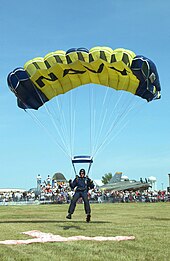
The primary mission of the Navy Parachute Team (NPT) is to support Naval Special Warfare recruiting by gaining access and exposure to appropriate candidates through aerial parachuting demonstrations.[155] The U.S. Navy Parachute Team is a fifteen-man team composed of U.S. Navy SEALs. Each member comes to the team for a three-year tour from one of the two Naval Special Warfare Groups located on the east and west coasts. On completion of the tour, members return to operational units.[156] The parachute team began in 1969 when Navy SEALs and Frogmen volunteered to perform at weekend air shows. The Team initially consisted of five jumpers: LCDR Olson, PHC Gagliardi, SK2 "Herky" Hertenstein, PR1 Al Schmiz and PH2 "Chip" Maury. Schmiz and Maury were members of the original "Chuting Stars."[157] When LCDR Olson was transferred to California, PHC Gene "Gag" Gagliardi (D 546) of UDT Eleven introduced him to the local jumping elite with the San Diego Skydivers, one of the nation's first sports parachuting clubs. He convinced the Commander Naval Operations Support Group, PACIFIC to create a small demonstration team consisting of a cadre of highly qualified freefall jumpers. Its activities were to be conducted on a "not to interfere" basis with other military duties and at no cost to the government, other than utilizing normally scheduled aircraft. This group eventually adopted the "Leap Frogs" name.[157]
The team was officially commissioned as the U.S. Navy Parachute Team in 1974 by the Chief of Naval Operations and assigned the mission of demonstrating Navy excellence throughout the United States. The East Coast-based "Chuting Stars" were disbanded in the 1980s with the "Leap Frogs" taking on all official parachute demonstrations within the Navy.
A typical Leap Frogs' performance consists of six jumpers leaping out of an aircraft at an altitude of 6,000 feet. After freefalling sometimes using smoke or streamers, the Leap Frogs fly their canopies together to build canopy-relative work formations. After performances, the Leap Frogs make themselves available to the public to answer questions about the Navy and the Naval Special Warfare community, as well as to sign autographs.
Influence on foreign units
From its predecessors, the
Due to their reputation as being one of America's premier special operations forces, SEALs (particularly operators from
National Navy UDT-SEAL Museum and memorial
The
Navy SEAL Memorial
According to the Navy SEAL Museum, 298 UDT and SEALs were killed in action and died during training accidents as of March 2018:[164]
- World War II and the Korean War (1941–1953):
- 96 personnel
- Vietnam and the Cold War (1954–1989):
- 104 personnel
- Desert Storm and the war on terror(1990 – March 2018):
- 98 personnel
Gallery
-
SEAL Tridents
-
SEALs prepare for a training mission aboard the USS George Washington.
-
A SEAL "Leap Frogs" parachute team high above San Diego
-
Two SEALs aiming their weapons
-
SEALs during aOperation Iraqi Freedom
-
SEAL team members participate in a tactical warfare training.
-
SEALs climb a caving ladder during a VBSS training.
-
A SEAL Team coming out of water
-
A SEAL at sunset
-
US Navy Basic Underwater Demolition-SEAL (BUD-S) students wade ashore on an Island during an exercise.
-
A SEAL takes up a defensive position in a village in northern Zabul province, Afghanistan, 10 April 2010.
-
SEALs demonstrate winter warfare capabilities.
-
A SEAL platoon performs a land warfare demonstration.
See also
- Naval Special Warfare Development Group, also known as SEAL Team Six, one of the five premier special mission unitsof the U.S. Armed Forces, composed solely of Navy SEALs – One of the United States' two secretive tier-one counter-terrorism and Special Mission UnitsPages displaying short descriptions of redirect targets
- Special warfare combatant-craft crewmen – U.S. Navy Special Warfare ForcePages displaying wikidata descriptions as a fallback
- List of United States Navy SEALs – Notable members of the US Navy SEALs and UDTs
- List of military special forces units – Compilation of world's military special forces
References
- ISBN 978-0312950521.
- ^ ""The Only Easy Day Was Yesterday" Navy SEALs (Sea, Air & Land)" (PDF). America's Navy. US Navy. Archived (PDF) from the original on 9 October 2022. Retrieved 26 January 2019.
- ^ "Larry Wilske". 2 July 2019.
- ^ "US joins battle as Philippines takes losses in besieged city". CNBC. 10 June 2017.
- ^ "Marawi siege: US special forces aiding Philippine army". BBC News Online. 10 June 2017.
- ^ Dancel, Raul (11 June 2017). "US special forces aid Philippine troops in battle for Marawi". The Straits Times.
- ^ a b c d e f g h i j "Navy SEAL History". Navy Seals.com. Archived from the original on 31 October 2016. Retrieved 16 May 2014.
- ^ "The difference between Navy SEALs and other military units". ATACLETE. 11 January 2023. Retrieved 3 February 2023.
- ^ "SEAL Requirements". Navy Seals.com. Retrieved 1 July 2011.
- ^ Laster, Jill (July 2011). "Program letting Coasties train as SEALs on hold". Navy Times.
- ^ a b c d e "Navy SEAL History". SEAL + SWCC. Retrieved 20 April 2014.
- ^ [7][9][10][11]
- ^ Waller, Douglas (3 February 2003). "The CIA's Secret Army". Time. Archived from the original on 9 May 2007.
- ISBN 978-0684811055.
- ISBN 978-0385732512.
- ^ a b "Army Officer Recalls Hunt for Bin Laden". 60 Minutes. CBS News. 5 October 2008.
- ^ "SEAL History: Origins of Naval Special Warfare-WWII".
- ^ "SEAL History: Origins of Naval Special Warfare-WWII". National Navy UDT-SEAL Museum. Retrieved 24 May 2014.
- ^ Blazich, Frank A. (6 June 2014). "Opening Omaha Beach: Ensign Karnowski and NCDU-45". Seabees Online. Navy Facilities Engineering Command, Washington Navy Yard, DC. Archived from the original on 3 September 2017. Retrieved 18 October 2017.
- ^ "Seal History: Origins of Naval Special Warfare – WWII". Navy Seal Museum Archives. Retrieved 18 October 2017.
- ^ "Naval Combat Demolition Units". specwarnet. Retrieved 10 December 2017.
- ^ "Blasting the Way to the Beachhead: US Navy Underwater Demolition Teams in the Pacific". The National WWII Museum | New Orleans. 19 April 2020. Retrieved 19 December 2021.
- ^ ISBN 1574882759
- ^ a b c World War II US Navy Special Warfare Units, Eugene Lipak, Osprey Publishing, POB 3985, NY, NY, 10185. 2014, p. 25
- ^ a b "A Glance at the Origins of Naval Special Warfare". United States Navy. 1 August 2018.
- ^ Central Intelligence Agency. "Special Operations". OSS Library. Archived from the original on 6 September 2015.
- ^ US National Archives. "The Big Picture #372 US ARMY". National Archives. Retrieved 2 May 2019.
- ^ PMID 15233157. Archived from the original on 13 May 2010. Retrieved 14 January 2012.)
{{cite journal}}: CS1 maint: unfit URL (link - PMID 15233156. Archived from the original on 13 May 2010. Retrieved 14 January 2012.)
{{cite journal}}: CS1 maint: unfit URL (link - ^ a b United States Army Special Operations Command. "Maritime Unit". soc.mil. Retrieved 2 May 2019.
- ^ Chace, Dave. "Dr. Christian Lambertsen: 70 years of influence on the military dive community". US Army. Retrieved 2 May 2019.
- ^ "OSS Maritime Unit".
- ^ a b c d "Series: OSS Training in the National Parks and Service Abroad in World War II". nps.gov. 8 August 2017.
- ^ a b c d e Gibbony, Lt. L.J. (23 May 1945). "Office of Strategic Services Report, Maritime Unit, Group A, OSS Combat Operations with UDT 10 from 10 August 1944 to 16 April 1945" (PDF). Missing Aircrew Project, Patrick Ranfranz. Archived (PDF) from the original on 9 October 2022. Retrieved 27 March 2019.
- ^ Bakuhatai, The Reconnaissance Mission of the USS Burrfish and the Fate of Three American POWs, by Nathaniel Patch, Prologue Magazine, Winter 2015, pp. 26–33, National Archives and Records Administration, Washington, DC [1]
- ^ "WWII UDT One & WWII UDT Two". View of the Rockies. Retrieved 18 October 2017.
- ^ ISBN 978-0553392197.
- ISBN 978-0307570062.
- ISBN 978-1497645639.
- ^ Submarine blasting, 301 NCB cruisebook, Seabee Museum Archives website, Jan 2020, p.60 [2]
- ^ a b "The Teams in World War II". View of the Rockies. Retrieved 18 October 2017.
- ^ "reply# 30, Seabees as UDTs, Interview with Wright S. Travis, member of OSS Maritime Unit attached to UDT 10". The Library of Congress. 20 November 2007.
- ^ Blazich, Frank A. (12 September 2016). "This Week in Seabee History (Week of September 11)". Seabees Online. Navy Facilities Engineering Command. Archived from the original on 13 October 2017. Retrieved 10 December 2017.
- ^ "'ALL HANDS', The Bureau of Naval Personal Information Bulletin Number 343" (PDF). NAVPERS. October 1945. pp. 12–15. Archived (PDF) from the original on 9 October 2022. Retrieved 27 March 2019.
- ^ "NCDU 216 Photo, National Navy UDT–SEAL Museum, North Hutchinson Island, Fort Pierce, FL".
- ^ ISBN 978-1612512983. Retrieved 27 March 2019.
- ^ ISBN 978-0312959852. Retrieved 27 March 2019.
- ^ "Sign 1967, Holiday Inn, Navy Seal Museum, Fort Pierce, 3300 N. Hwy. A1A, North Hutchinson Island, Fl 34949".
- ^ Operations Crossroads, DNA 6032F, prepared by the Defense Nuclear Agency, p. 189 [3] Archived 25 March 2021 at the Wayback Machine
- ^ "SEAL History: Underwater Demolition Teams in the Korean War". National Navy UDT-SEAL Museum. Retrieved 24 May 2014.
- ^ "Genesis of the U.S. Navy's SEa, Air, Land (SEAL) Teams". National Navy UDT-SEAL Museum. Archived from the original on 22 February 2014. Retrieved 24 May 2014.
- ^ "Video gallery: Forged by Adversity". United States Navy. 2 January 2013.
- ISBN 978-0671536251.
- ISBN 038071986X.
- ^ US Navy SEAL Combat Manual (PDF). 1974. p. xvi. Archived (PDF) from the original on 9 October 2022..
- ISBN 080410722X.
- ^ Couch (2008).
- ^ United States Special Operations Command. "Naval Special Warfare Command". socom.mil. Archived from the original on 28 June 2018. Retrieved 6 May 2018.
- ^ a b c Cawthorne (2008).
- ^ Neville (2015), p. 14.
- ^ Friedman, Herbert A. "United States PSYOP in Somalia". Psywarrior. Retrieved 2 December 2012.
- ^ Borchini, Charles P. (Lt. Col.); Borstelmann, Mari (October 1994). "PSYOP in Somalia: The Voice of Hope" (PDF). Special Warfare. United States Army. Archived (PDF) from the original on 9 October 2022.
- ISBN 978-1847445490.
- ^ Neville (2015), pp. 25–31.
- ^ Neville (2015), p. 44.
- ^ Neville (2015), pp. 49–50 & 77.
- ^ Neville (2015), p. 78.
- ^ Neville (2015), pp. 54–69.
- ^ Neville (2015), p. 83.
- ^ Neville (2015), p. 166.
- ^ Neville (2015), pp. 161–162.
- ^ a b "DOD Identifies Service Members Killed in CH-47 Crash". U.S. Department of Defense, Office of the Assistant Secretary of Defense (Public Affairs). 11 August 2011.
- ^ King, Laura; Dilanian, Ken; Cloud, David S. (6 August 2011). "SEAL Team 6 members among 38 killed in Afghanistan". Los Angeles Times.
- Fox News Channel. 6 August 2011.
- ^ "Pentagon releases names of Chinook crash victims". CNN News. 12 August 2011. Archived from the original on 13 August 2011. Retrieved 14 August 2011.
- ^ Neville (2015), p. 162.
- ^ Shumaker, Lisa (11 December 2012). "Navy identifies SEAL killed in hostage rescue in Afghanistan". Yahoo! News. Archived from the original on 18 December 2012.
- ^ "Obama to present Medal of Honor to Navy SEAL". Yahoo! News. Retrieved 2 June 2016.
- ^ Parsons, Dan (15 May 2013). "SEALs to Undergo 'Evolution in Reverse' as They Return to Maritime Operations". National Defense. National Defense Industrial Association.
- ^ Neville (2015), p. 96.
- ^ Neville (2015), p. 123.
- ^ Neville (2015), pp. 123–126.
- ^ Rossiter (2009), pp. 149, 153 & 158–162.
- ^ a b c d e Kyle (2013).
- ^ Neville (2015), pp. 126–127.
- ^ Neville (2015), p. 127.
- ^ Rossiter (2009), p. 161.
- ISBN 978-0525953722.
- ^ [84][86][87][88]
- ^ Rossiter (2009), pp. 325–328.
- ^ Neville (2015), p. 126.
- ^ Neville (2015), pp. 178–179.
- ^ Neville (2015), pp. 175–178.
- ^ Neville (2015), pp. 179–180.
- ^ "A Navy SEAL loadout in Ramadi". Corpi d'élite.net. 14 May 2017. Retrieved 1 October 2017.
- ^ Neville (2015), pp. 180–182.
- ^ Neville (2015), p. 182.
- ISBN 978-0306823091.
- ^ "Navy SEAL not guilty of charges in Iraq". CNN. 22 April 2010.
- Fox News Channel.
- ^ Hartwell, Ray V. (26 November 2013). "Persecuting Our Heroes". The American Spectator.
- ^ Neville (2015), pp. 184–185.
- ^ Neville (2015), pp. 200–201.
- ^ Neville (2015), pp. 282–284.
- ^ Neville (2015), p. 285.
- ^ "U.S. warship near boat carrying pirates". CNN. 9 April 2009.
- ^ Flock, Elizabeth (2 May 2011). "Navy SEALs who killed Osama bin Laden are from the elite 'Team 6'". The Washington Post.
- ^ a b "The raid on Osama bin Laden's compound". CBS News. 2 May 2011.
- ^ "Osama bin Laden killed in CIA operation". The Washington Post. 8 May 2011.
- ^ Winter, Jana (25 May 2011). "Mickey Mouse Surrenders to Navy SEALs in Trademark Battle". Fox News Channel.
- ^ "Model of Osama bin Laden Abbottabad Compound". National Navy UDT-SEAL Museum. Retrieved 24 May 2014.
- ^ "Navy Seals board rogue Libya oil tanker Morning Glory". BBC News. 17 March 2014.
- ^ "Navy SEALS board, take control of rogue Libya tanker". Fox News Channel. 17 March 2014.
- ^ a b "Revelation of March ISIS battle highlights risks for U.S. troops". CNN. 20 June 2016.
- ^ "U.S. Navy SEAL killed in Iraq battle vs. ISIS". CBS News. 3 May 2016.
- ^ "Navy SEAL Charles Keating IV gave life rescuing others from ISIS". CNN. 3 May 2016.
- ^ "Inside the Battle With ISIS that Killed a US Navy SEAL". ABC News. 4 May 2016.
- ^ "Navy SEAL Enlisted General Requirements". SEAL+SWCC. Retrieved 28 September 2015.
- ^ "Enlisted SEAL Requirements". Navy Seals.com. Retrieved 28 September 2015.
- ^ "FAQ". SEAL+SWCC. Retrieved 30 May 2015.
- ^ "BUD/S". Navy SEALs. Archived from the original on 4 April 2016. Retrieved 2 June 2016.
- ^ a b "Navy SEALs". Navy.com.
- ^ a b "Navy SEALs Training Stages Overview". SEAL+SWCC. Archived from the original on 3 May 2013. Retrieved 23 April 2013.
- ^ "Navy SEAL Platoon Training". Navy SEALs Information & Resources. 4 September 2009. Archived from the original on 9 May 2014. Retrieved 9 May 2014.
- ^ "Special Operations Combat Medic Course". U.S. Navy. Archived from the original on 12 April 2021. Retrieved 6 October 2014.
- ^ a b Larter, David; Myers, Meghann (19 August 2015). "Navy SEALs set to open to women, top admiral says". Navy Times.
- ^ Crockett, Emily (3 December 2015). ""No exceptions": Women can now serve in all military combat roles". Vox.
- ^ LaGrone, Sam (15 July 2021). "First Female Navy Special Operations Sailor Graduates from Training". USNI News.
- The Washington Examiner.
- ^ Seck, Hope Hodge (11 December 2019). "The First Woman Has Made it Through SEAL Officer Screening". Military.com. Retrieved 12 December 2019.
- ^ Seck, Hope Hodge (11 December 2019). "The First Woman Has Made it Through SEAL Officer Screening". Military Times. Retrieved 24 March 2021.
- ISSN 0362-4331. Retrieved 5 January 2022.
- ^ "Naval Special Warfare Welcomes CQT Class 115; First Woman Operator". DVIDS. Retrieved 5 January 2022.
- ^ a b "Navy SEAL drug use "staggering," investigation finds". CBS. 11 April 2017.
- ^ "Allegations of sexual assault, cocaine use among SEAL teams prompt 'culture' review". CNN. 12 August 2019.
- ^ "Special Operations Forces, Fiscal Year 2014 p.46" (PDF). Government Accountability Office. July 2015. Archived (PDF) from the original on 9 October 2022.
- ^ "Structure". Navy Seals.com. Archived from the original on 14 December 2018. Retrieved 10 December 2018.
- ^ "Join Special Reconnaissance Team". Archived from the original on 19 May 2023. Retrieved 19 May 2023.
- ^ a b c "U.S. Naval Special Warfare Command Establishes Group Eight, Disestablishes Groups Three and Ten". DVIDSHUB. 25 August 2021. Archived from the original on 29 August 2021. Retrieved 21 July 2022.
- ^ a b c Atlamazoglou, Stavros (15 September 2021). "To take on Russia and China, the US Navy is standing up a new unit to do the missions that only SEALs can do". Business Insider. Archived from the original on 7 July 2022. Retrieved 21 July 2022.
- ^ "Fact Book 2022" (PDF). SOCOM. 2022. Archived from the original (PDF) on 4 July 2022. Retrieved 21 July 2022.
- ^ "Naval Special Warfare Welcomes Group 10 to Force". United States Navy. 26 May 2011. Retrieved 3 January 2018.
- ^ a b c Menzie, Christopher (8 August 2008). "Naval Special Warfare Reserve Command Renamed". U.S. Navy.
- ^ "US Navy SEALs". Duniakemilauemas.blogspot.com. 4 October 2011.
- ^ Crosby, Tommy (12 December 2007). "SEAL Team 7 Holds Change of Command". U.S. Navy.
- ^ "Archived copy". Facebook. Archived from the original on 8 March 2021. Retrieved 23 May 2019.
{{cite web}}: CS1 maint: archived copy as title (link) - ^ Faram, Mark D. (25 February 2019). "SEALs revive stealthy submarine delivery team in Virginia". Navy Times.
- ^ Army Command and General Staff College. 1999.
- ^ "Navy Special Warfare Operator Rating (SEAL)". Navycs.com. 21 December 2016.
- ^ Menzie, Christopher (10 October 2006). "NSW Community Establishes New SO and SB Ratings". U.S. Navy.
- ^ "SEALs and SWCCs drop source ratings". SOCNET: The Special Operations Community Network. 11 October 2006.
- ^ "Special Warfare Operator (SO)" (PDF). Manual of Navy Enlisted Manpower and Personnel Classifications and Occupational Standards. Vol. I. Archived from the original (PDF) on 25 May 2014. Retrieved 24 May 2014.
- ^ "Bachelor of Science in Business Administration with a concentration in General Management" (PDF). Trident University International. 23 August 2013. Archived (PDF) from the original on 9 October 2022.
- ^ "Degree Map for a Bachelor of Arts in Interdisciplinary Studies (IDSS): SO – Special Warfare Operator" (PDF). Governors State University. Archived from the original (PDF) on 28 May 2010. Retrieved 6 October 2014.
- ^ "Navy Parachute Team handbook" (PDF). U.S. Navy. Archived from the original (PDF) on 22 July 2011.
- ^ "Leap Frogs". Official U.S. Navy Parachute Team Web Site. Archived from the original on 5 October 2011. Retrieved 1 October 2011.
- ^ a b "SEAL History: The Leap Frogs-Origins of the Navy SEAL Parachuting Exhibition Team". National Navy UDT-SEAL Museum. Archived from the original on 29 October 2013. Retrieved 24 May 2014.
- ^ Government of Pakistan, Navy Press Release. "Special Service Group (Navy)". The Directorate-General for the Naval Inter-Services Public Relations (Navy ISPR). Naval Inter-Services Public Relations (Navy ISPR). Archived from the original on 19 April 2012. Retrieved 19 April 2012.
- ^ "Marine Commando Force". Specialoperations.com. Archived from the original on 5 July 2012. Retrieved 15 July 2012.
- ^ Couch (2008), p. 54.
- ISBN 978-0751531657.
- ^ "The Origin of the UDT-SEAL Museum". National Navy UDT-SEAL Museum. Archived from the original on 10 March 2014. Retrieved 24 May 2014.
- ^ "Ft. Pierce Museum Now the Official National Museum of Navy SEALs and Their Predecessors". NavySEALs.com. Archived from the original on 13 June 2011. Retrieved 1 October 2011.
- ^ "The Navy SEAL Memorial Wall". National Navy UDT-SEAL Museum. Retrieved 23 January 2019.
Bibliography
- Besel, Jennifer M. The Navy SEALs. Mankato, Minn: Capstone Press, 2011. OCLC 649079630.
- Bosiljevac, T. L. SEALs: UDT/SEAL Operations in Vietnam. Ballantine Books, 1990. OCLC 23228772.
- Bosiljevac, T. L. SEAL Team Roll-Back. New York: Avon Books, 1999. OCLC 41020614.
- Bahmanyar, Mir. US Navy SEALs. Oxford: Osprey Publishing, 2005. OCLC 62176513.
- Bahmanyar, Mir with Chris Osman. SEALs: The US Navy's Elite Fighting Force. Osprey Publishing, 2008. OCLC 191922842.
- ISBN 978-1845298210.
- Couch, Dick. May the Seals: Their untold history (2014)
- ISBN 978-1591141389.
- Couch, Dick. The Warrior Elite: The Forging of SEAL Class 228. New York: Three Rivers Press, 2003. OCLC 802957824.
- Couch, Dick. The Finishing School: Earning the Navy SEAL Trident. New York: Three Rivers Press, 2004. OCLC 60563833.
- Couch, Dick. Down Range: Navy SEALs in the War on Terrorism. New York: Three Rivers Press, 2005. OCLC 71199069.
- Cummings, Dennis J. The Men Behind the Trident: SEAL Team One in Viet Nam. New York: Bantam Books, 1998. OCLC 39494815.
- Denver, Rorke, and Ellis Henican. Damn Few: Making the Modern SEAL Warrior. New York: Hyperion, 2013. OCLC 795757181.
- Dockery, Kevin. Navy SEALs: A History of the Early Years. New York: OCLC 0425178250.
- Dockery, Kevin. Navy SEALs: A History Part II: The Vietnam Years. New York: Berkley Books, 2002. OCLC 48449554.
- Dockery, Kevin. Navy SEALs: A History Part III: Post-Vietnam to the Present. New York: Berkley Books, 2003. OCLC 51818673.
- Dockery, Kevin. Weapons of the Navy SEALs. New York: Berkley Books, 2004. OCLC 56347561.
- Donald, Mark L., and Scott Mactavish. Battle Ready: Memoir of a SEAL Warrior Medic. New York: St. Martin's Press, 2013. OCLC 759914152.
- Fawcett, Bill. Hunters and Shooters: An Oral History of the U.S. Navy SEALs in Vietnam. New York: W. Morrow and Co., 1995. OCLC 31520013.
- Freid-Perenchio, Stephanie, and Jennifer Walton. SEAL: The Unspoken Sacrifice. [Ketchum, ID]: SFP Studio, 2009. OCLC 525383689.
- Greitens, Eric. The Heart and the Fist: The Education of a Humanitarian, the Making of a Navy SEAL. Boston: Houghton Mifflin Harcourt, 2011. OCLC 646308409.
- Halberstadt, Hans. US Navy SEALs in Action. Osceola, WI: Motorbooks International, 1995. OCLC 32275764.
- Jansing, Chris (29 January 2010). "A typical SEAL? Think 007, not Rambo". NBC Field Notes (NBC News). Archived from the original on 31 January 2010. Retrieved 29 January 2010.
- Kelly, Orr. Never Fight Fair!: Navy SEALs' Stories of Combat and Adventure. Novato, CA: Presidio Press, 1995. OCLC 30894438.
- ISBN 978-0062082350.
- Luttrell, Marcus. Lone Survivor: The Eyewitness Account of Operation Redwing and the Lost Heroes of SEAL Team 10. Little, Brown and Company, 2009. OCLC 319610219.
- Luttrell, Marcus., and James D. Hornfischer. Service: A Navy SEAL at War. New York: Little, Brown and Co., 2012. OCLC 756584153.
- Mann, Don, and Ralph Pezzullo. Inside SEAL Team Six: My Life and Missions with America's Elite Warriors. New York: Little, Brown & Co., 2011. OCLC 729343843.
- McEwen, Scott, and Richard Miniter. Eyes on Target: Inside Stories from the Brotherhood of the U.S. Navy SEALs. New York: Center Street, 2014. OCLC 828891431.
- Neville, Leigh (2015). Special Forces in the War on Terror. ISBN 978-1472807908.
- Neville, Leigh. Takur Ghar: The SEALs and Rangers on Roberts Ridge, Afghanistan 2002. Oxford, UK: Osprey Pub., 2013. OCLC 798058824.
- O'Donnell, Patrick K. First SEALs: The Untold Story of the Forging of America's Most Elite Unit (Da Capo, 2014) online review
- Owen, Mark, and Kevin Maurer. No Easy Day: The Autobiography of s Navy SEAL: the Firsthand Account of the Mission That Killed Osama Bin Laden. New York: Dutton, 2012. OCLC 808121503.
- Padden, Ian. U.S. Navy SEALs. Toronto: Bantam Books, 1985. OCLC 12264420.
- Pfarrer, Chuck. SEAL Target Geronimo: The Inside Story of the Mission to Kill Osama Bin Laden. New York: St. Martin's Press, 2011. OCLC 733234790.
- Pfarrer, Chuck. Warrior Soul: The Memoir of a Navy SEAL. New York: Random House, 2004. OCLC 52165997.
- Redman, Jason, and John R. Bruning. The Trident: The Forging and Reforging of a Navy SEAL Leader. New York: William Morrow, 2013. OCLC 827260093.
- Robinson, Patrick. Honor and Betrayal: The Untold Story of the Navy SEALs Who Captured the "Butcher of Fallujah"- and the Shameful Ordeal They Later Endured. Cambridge, Massachusetts: Da Capo Press, 2013. OCLC 861508106.
- Rossiter, Mike (2009). Target Basra. London: ISBN 978-0552157001.
- Sasser, Charles W. Encyclopedia of the Navy SEALs. New York: Facts on File, 2002. OCLC 48383497.
- Wasdin, Howard E., and Stephen Templin. SEAL Team Six: Memoirs of an Elite Navy SEAL Sniper. New York: St. Martin's Press, 2011. OCLC 681499659.
External links
- Official website
- United States Navy Parachute Team – official website
- "Navy Fact File: Navy SEALs". San Diego: United States Navy. April 2002. Archived from the original on 3 March 2005. Retrieved 25 June 2006.
- Peterson, Lt. Cmdr Erick (June 2009). "The Strategic Utility of U.S. Navy SEALs". Master thesis (dtic.mil). Naval Postgraduate School. Archived from the original on 1 December 2012. Retrieved 17 January 2012.
- SEAL The Unspoken Sacrifice exhibit at the Pritzker Military Museum & Library
- McCoy, Shane T. (August 2004). "Testing Newton's Law", All Hands Magazine, p. 33.
- Obringer, Lee Ann. "How the Navy SEALs Work". How Stuff Works. Retrieved 14 June 2006.
- Navy SEALs 50 – Commemorating the 50th Anniversary of the Establishment of the U.S. Navy SEALs
- Ethos of the Navy SEALs
Naval special operations forces | |
|---|---|
| Current |
|
| Defunct | |












